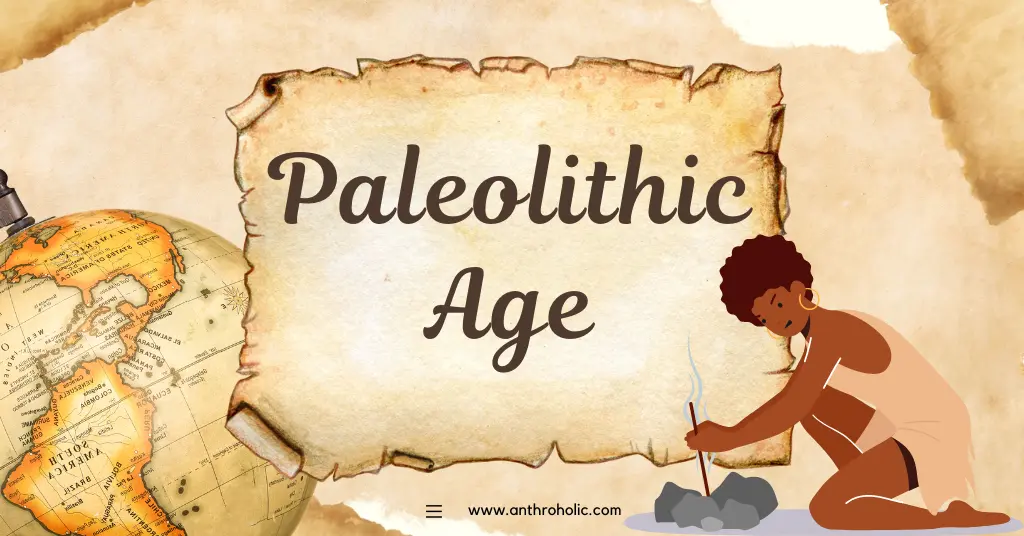AI Answer Evaluation Platform Live Now. Try Free Answer Evaluation Now
Paleolithic Age
The Paleolithic Age, also known as the Stone Age, is characterized as the period of human history that began roughly 2.6 million years ago and ended around 10,000 BCE. During this period, our early ancestors learned to master tools, develop rudimentary societies, and survive in various ecological environments.

The Division of the Paleolithic Age
The Paleolithic Age is typically divided into three distinct periods: Lower, Middle, and Upper Paleolithic.
- Lower Paleolithic (2.6 million – 300,000 years ago): Marked by the first use of stone tools.
- Middle Paleolithic (300,000 – 45,000 years ago): Associated with the rise of Neanderthals and early Homo sapiens.
- Upper Paleolithic (45,000 – 10,000 years ago): Characterized by advancements in tool-making, the development of cave art, and the eventual extinction of Neanderthals.
Tools and Technological Development
Lower Paleolithic saw the advent of simple stone tools, while Upper Paleolithic demonstrated a significant improvement in tool-making techniques. Some characteristic Paleolithic tools included:
- Hand axes
- Scrapers
- Levallois points
- Mousterian tools
| Period | Predominant Tools |
|---|---|
| Lower Paleolithic | Hand axes, choppers |
| Middle Paleolithic | Levallois points, Mousterian tools |
| Upper Paleolithic | Blades, end scrapers, burins |
Society and Culture
Paleolithic societies were primarily organized around small, nomadic bands. Social structures were likely based on kinship ties. As hunter-gatherers, these early humans relied on hunting large game and gathering plant foods. Notably, the Upper Paleolithic period saw an explosion in cultural expression, such as:
- Cave paintings: E.g., Lascaux Cave in France, Altamira in Spain.
- Sculptures: E.g., Venus figurines.
- Music instruments: Flutes made of bones and antlers.
The cultural artifacts from this time provide invaluable insights into early human cognition and societal organization.
Environment and Migration
The Paleolithic Age witnessed significant climatic fluctuations, including multiple ice ages. These shifts shaped human migration, resource availability, and survival strategies. Humans initially populated Africa before migrating to other parts of the globe.
Impact of Climate Changes
The climate played a crucial role during the Paleolithic Age. The Pleistocene epoch, or the last ice age, saw many glaciers expand and contract. These cyclical glacial periods significantly influenced human habitation and migration patterns.
Habitation and Migration Patterns
- Africa: Early hominids first appeared in Africa, with Homo erectus emerging around 1.9 million years ago.
- Asia: Homo erectus migrated out of Africa into Asia approximately 1.8 million years ago.
- Europe: Homo heidelbergensis and Neanderthals colonized Europe around 800,000 years ago.
- Americas: The migration to the Americas is believed to have occurred between 15,000 – 20,000 years ago, towards the end of the Paleolithic Age.
These migrations resulted in the dispersal of Homo sapiens across the globe, leading to the development of distinct regional cultures and technologies.
Adaptation to Diverse Ecosystems
The Paleolithic Age saw humans adapting to various ecological environments, from the harsh tundra of Ice Age Europe to the tropical climates of Africa and Asia. Survival in these diverse environments demanded a high degree of cognitive and technological flexibility, driving the evolution of complex stone tool technologies, fire usage, and clothing.
The Transition to Agriculture
A significant shift occurred at the end of the Paleolithic Age with the invention of agriculture. The Neolithic Revolution, as this change is called, allowed for the domestication of plants and animals, providing more reliable food sources. The implications of this revolution were profound, leading to permanent settlements, population growth, and ultimately, the development of complex civilizations.
| Period | Predominant Lifestyle | Key Developments |
|---|---|---|
| Paleolithic Age | Nomadic hunter-gatherers | Development of stone tools, mastery of fire, cave art |
| Neolithic Age | Settled farming communities | Agriculture, animal domestication, pottery, woven textiles |
The Legacy of the Paleolithic Age
The legacy of the Paleolithic Age is profound and far-reaching. The cultural, technological, and social innovations of this era form the bedrock of human civilization. Understanding our Paleolithic heritage provides insights into the evolution of human cognition, societal structures, and our relationship with the natural world.
The End of the Paleolithic Age
The conclusion of the Paleolithic Age is marked by the advent of the Neolithic Age or the New Stone Age, around 10,000 BCE. This shift was catalyzed by the development of agriculture, allowing human societies to transition from nomadic to sedentary lifestyles.
References:
- Klein, Richard. “The Human Career: Human Biological and Cultural Origins”. Chicago: University of Chicago Press, 2009.
- Mithen, Steven. “The Prehistory of the Mind: The Cognitive Origins of Art, Religion and Science”. London: Thames & Hudson, 1996.
- Scarre, Chris (ed.). “The Human Past: World Prehistory & the Development of Human Societies”. London: Thames & Hudson, 2005. http://dx.doi.org/10.1177/14619571050080030512
- Stringer, Chris, and Peter Andrews. “The Complete World of Human Evolution”.
- Potts, Richard. “Humanity’s Descent: The Consequences of Ecological Instability”. New York: William Morrow and Co., 1996.
- Bocquet-Appel, Jean-Pierre. “When the World’s Population Took Off: The Springboard of the Neolithic Demographic Transition”. Science, 2011.
- Meltzer, David. “First Peoples in a New World: Colonizing Ice Age America”. Berkeley: University of California Press, 2009.




